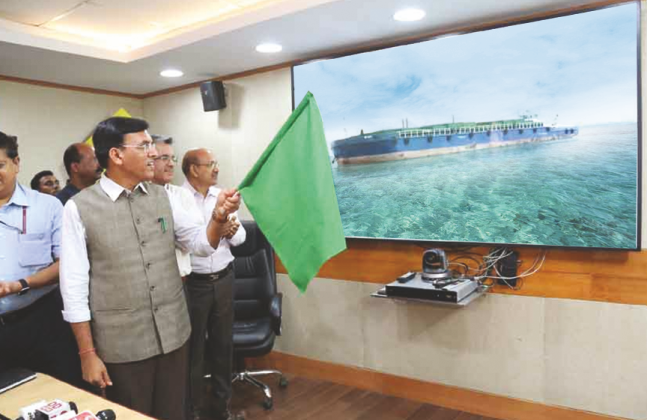Transport of cargo from Bhutan to Bangladesh through Indian waterway will cut short travel time by 8 to 10 days and will also reduce transportation cost by 30 per cent
Indian inland waterway will now be used for enhancing much easier and cheaper cargo transportation between Bangladesh and Bhutan.As India has opened its river route through Brahmaputra River, as part of the Indo- Bangladesh protocol route.
The Minister of State for Shipping (Independent Charge) and Chemical and Fertilisers Mansukh Mandaviya digitally flagged off the first Inland Waterways Authority of India’s (IWAI’s) 2,000t self-propelled MV AAI vessel carrying about 1,000mt of cargo of crushed stones from Dhubri port in Assam to Narayanganj in Bangladesh on 12 July 2019. This new route development is in line with Prime Minister Narendra Modi’s vision of promoting cargo transportation via inland waterways.
“This is the first time an Indian waterway is being used as a channel for transport of cargo between two countries, using India for transit,” Shipping Minister Mansukh Mandaviya said while flagging off the ship.
IWAI responsible for the developing and maintaining national waterways has carried out capital dredging on Brahmaputra to maintain an assured draft in navigation channel. Maintenance dredging will be carried out as and when required. Moreover, India has also agreed to offer T300 crore to Bangladesh for maintaining the depth of water on this route for five years.
The stone aggregates were transported by trucks from Phuentsholing in Bhutan which is located 160km from IWAI’s Dhubri jetty in Asaam. The stone aggregates will sail from the Dhubri port in Assam to Narayanganj in Bangladesh through India’s National Waterways 2 and Indo-Bangladesh Protocol Route. The ship will cover 600 km in six days to reach Narayanganj.
Until now, the trucks of landlocked Bhutan used to ply to Bangladesh with the cargo. At the border, cargo from Bhutan’s trucks get unloaded and reloaded into trucks of Bangladesh. This also involved a customs clearance time of and long queues of truck taking a time of up to 20 days.
The movement of cargo from Bhutan to Bangladesh using Indian inland waterway will offer larger shipment size as compared to road. The 1,000mt of stone aggregates currently being transported to Bangladesh is equivalent to replace 70 trucks of 12 wheels of 50 trucks of 16 wheels. It will reduce travel time by 8 to 10 days, and will cut down transportation cost by 30 per cent and will bring down logistics costs. The cost saving will be higher if the return cargo were to be taken into consideration. As it is expected that Bangladesh will send jute and rice to Bhutan in turn cargo.
The movement of cargo from Bhutan to Bangladesh using Indian inland waterway will offer larger shipment size as compared to road. The 1,000mt of stone aggregates currently being transported to Bangladesh is equivalent to replace 70 trucks of 12 wheels of 50 trucks of 16 wheels. It will reduce travel time by 8 to 10 days, and will cut down transportation cost by 30 per cent and will bring down logistics costs. The cost saving will be higher if the return cargo were to be taken into consideration. As it is expected that Bangladesh will send jute and rice to Bhutan in turn cargo.
This movement is expected to inspire confidence among the Bhutanese exporters to increasingly shift to waterways mode and increase the trade of stone aggregates and other cargo between Bhutan and Bangladesh through India’s inland waterways. Bhutanese exporters and importers are now expected to use this route frequently








